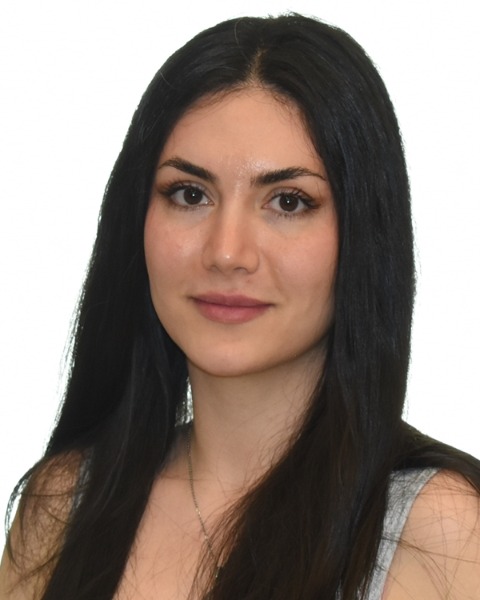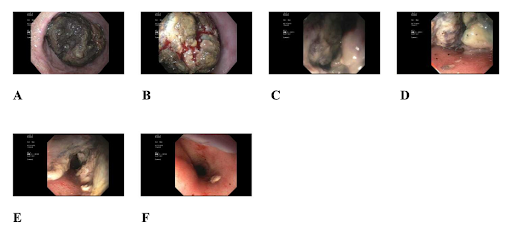Tuesday Poster Session
Category: Esophagus
P5032 - A Rare Case of a Near-Occluding Esophageal Leiomyosarcoma
Tuesday, October 28, 2025
10:30 AM - 4:00 PM PDT
Location: Exhibit Hall

Sara Sadeghi, MD (she/her/hers)
NYC Health + Hospitals/South Brooklyn Health
Brooklyn, NY
Presenting Author(s)
Sara Sadeghi, MD, Jessica Efa, MD, Maureen Okafor, MD, MPH, Hannah Shoctor, MPH, Joshua Diaz, MD, Sara Samad, DO, Alla Bogorodovsky, MD, John Trillo, MD
NYC Health + Hospitals/South Brooklyn Health, Brooklyn, NY
Introduction: Esophageal leiomyosarcoma is a rare, slow-growing malignant neoplasm with smooth muscle origin and late metastasis. The main symptoms in patients with this type of tumor are not different from other esophageal masses.
The diagnosis of leiomyosarcoma is usually on a histopathologic basis and on rare cases by endoscopic ultrasound-guided fine-needle aspiration biopsy. Esophageal leiomyosarcoma is the most common of all esophageal sarcomas. However, its incidence rate is low - less than 0.2%.
Case Description/
Methods: This is a case of a 75 y/o female who presented with progressive dysphagia, postprandial nausea and vomiting, constipation, and a gradual decline in oral intake of both solids and liquids, epigastric pressure-like discomfort, anorexia, and weight loss. Her past medical history included spastic cerebral palsy, hypertension, GERD, and chronic hypokalemia.
CT scan showed a significantly dilated esophagus measuring about 5.5 cm with a large volume of hypoattenuating material displacing the oral contrast with raised suspicion for achalasia or an esophageal dysmotility disorder. Chest imaging also revealed prominent paraesophageal lymphadenopathy and multiple bilateral lung novules measuring up to 7mm. Given these findings, an upper endoscopic evaluation was performed which revealed a large fungating necrotic mass in the esophagus located 20 cm from the incisors. Pathology showed a poorly differentiated malignant neoplasm consistent with esophageal leiomyosarcoma positive for smooth muscle actin (SMA), caldesmon, and calponin (focal/weak), and negative for desmin, S100, CD117, DOG-1, CK5/6, P63 and CK AE1/AE3.
Discussion: Esophageal leiomyosarcoma is an extremely rare tumors, with approximately 200 total cases reported worldwide which is most commonly found in the lower third of the esophagus.
Diagnostic measures include barium swallow, CT scan and endoscopy. The mainstay for treatment of esophageal leiomyosarcoma is surgical resection. Although esophageal leiomyosarcoma exhibits poor sensitivity to radiation, radiotherapy may also be used adjunctively or in inoperable or extensive leiomyosarcomas to achieve tumor control.
Esophageal leiomyosarcoma exhibits a better prognosis than other esophageal cancer subtypes due to its slow growing nature and late metastases. This patient, in light of an advanced disease elected for palliative management and supportive care. In such a case, early diagnosis may have prompted a more aggressive treatment approach with higher prognostic probability.

Figure: Figure 1. Axial (A) and sagittal (B) views of chest computer tomography images showing middle to distal third esophageal leiomyosarcoma with orange measuring line at areas of widest esophageal diameter. A large hypoattenuating mass is seen displacing oral contrast proximally to distally (B).

Figure: Figure 2. A large fungating necrotic mass in the esophagus located 20 cm from the incisors down to 35 cm by the gastroesophageal (GE) junction. Mass surface covered in food debris (A) with minimal oozing of blood (B). Mass is partially circumferential involving more than two-thirds lumen circumference with near-occlusion of middle third of the esophagus (A and B). Biopsies for histology collected with cold forceps. Adult and pediatric gastroscopes were utilized to advance beyond to the distal third of the esophagus, stomach and duodenum (C, D, E). Hiatal hernia and mass noted at the GE junction (F).
Disclosures:
Sara Sadeghi indicated no relevant financial relationships.
Jessica Efa indicated no relevant financial relationships.
Maureen Okafor indicated no relevant financial relationships.
Hannah Shoctor indicated no relevant financial relationships.
Joshua Diaz indicated no relevant financial relationships.
Sara Samad indicated no relevant financial relationships.
Alla Bogorodovsky indicated no relevant financial relationships.
John Trillo indicated no relevant financial relationships.
Sara Sadeghi, MD, Jessica Efa, MD, Maureen Okafor, MD, MPH, Hannah Shoctor, MPH, Joshua Diaz, MD, Sara Samad, DO, Alla Bogorodovsky, MD, John Trillo, MD. P5032 - A Rare Case of a Near-Occluding Esophageal Leiomyosarcoma, ACG 2025 Annual Scientific Meeting Abstracts. Phoenix, AZ: American College of Gastroenterology.
NYC Health + Hospitals/South Brooklyn Health, Brooklyn, NY
Introduction: Esophageal leiomyosarcoma is a rare, slow-growing malignant neoplasm with smooth muscle origin and late metastasis. The main symptoms in patients with this type of tumor are not different from other esophageal masses.
The diagnosis of leiomyosarcoma is usually on a histopathologic basis and on rare cases by endoscopic ultrasound-guided fine-needle aspiration biopsy. Esophageal leiomyosarcoma is the most common of all esophageal sarcomas. However, its incidence rate is low - less than 0.2%.
Case Description/
Methods: This is a case of a 75 y/o female who presented with progressive dysphagia, postprandial nausea and vomiting, constipation, and a gradual decline in oral intake of both solids and liquids, epigastric pressure-like discomfort, anorexia, and weight loss. Her past medical history included spastic cerebral palsy, hypertension, GERD, and chronic hypokalemia.
CT scan showed a significantly dilated esophagus measuring about 5.5 cm with a large volume of hypoattenuating material displacing the oral contrast with raised suspicion for achalasia or an esophageal dysmotility disorder. Chest imaging also revealed prominent paraesophageal lymphadenopathy and multiple bilateral lung novules measuring up to 7mm. Given these findings, an upper endoscopic evaluation was performed which revealed a large fungating necrotic mass in the esophagus located 20 cm from the incisors. Pathology showed a poorly differentiated malignant neoplasm consistent with esophageal leiomyosarcoma positive for smooth muscle actin (SMA), caldesmon, and calponin (focal/weak), and negative for desmin, S100, CD117, DOG-1, CK5/6, P63 and CK AE1/AE3.
Discussion: Esophageal leiomyosarcoma is an extremely rare tumors, with approximately 200 total cases reported worldwide which is most commonly found in the lower third of the esophagus.
Diagnostic measures include barium swallow, CT scan and endoscopy. The mainstay for treatment of esophageal leiomyosarcoma is surgical resection. Although esophageal leiomyosarcoma exhibits poor sensitivity to radiation, radiotherapy may also be used adjunctively or in inoperable or extensive leiomyosarcomas to achieve tumor control.
Esophageal leiomyosarcoma exhibits a better prognosis than other esophageal cancer subtypes due to its slow growing nature and late metastases. This patient, in light of an advanced disease elected for palliative management and supportive care. In such a case, early diagnosis may have prompted a more aggressive treatment approach with higher prognostic probability.

Figure: Figure 1. Axial (A) and sagittal (B) views of chest computer tomography images showing middle to distal third esophageal leiomyosarcoma with orange measuring line at areas of widest esophageal diameter. A large hypoattenuating mass is seen displacing oral contrast proximally to distally (B).

Figure: Figure 2. A large fungating necrotic mass in the esophagus located 20 cm from the incisors down to 35 cm by the gastroesophageal (GE) junction. Mass surface covered in food debris (A) with minimal oozing of blood (B). Mass is partially circumferential involving more than two-thirds lumen circumference with near-occlusion of middle third of the esophagus (A and B). Biopsies for histology collected with cold forceps. Adult and pediatric gastroscopes were utilized to advance beyond to the distal third of the esophagus, stomach and duodenum (C, D, E). Hiatal hernia and mass noted at the GE junction (F).
Disclosures:
Sara Sadeghi indicated no relevant financial relationships.
Jessica Efa indicated no relevant financial relationships.
Maureen Okafor indicated no relevant financial relationships.
Hannah Shoctor indicated no relevant financial relationships.
Joshua Diaz indicated no relevant financial relationships.
Sara Samad indicated no relevant financial relationships.
Alla Bogorodovsky indicated no relevant financial relationships.
John Trillo indicated no relevant financial relationships.
Sara Sadeghi, MD, Jessica Efa, MD, Maureen Okafor, MD, MPH, Hannah Shoctor, MPH, Joshua Diaz, MD, Sara Samad, DO, Alla Bogorodovsky, MD, John Trillo, MD. P5032 - A Rare Case of a Near-Occluding Esophageal Leiomyosarcoma, ACG 2025 Annual Scientific Meeting Abstracts. Phoenix, AZ: American College of Gastroenterology.
